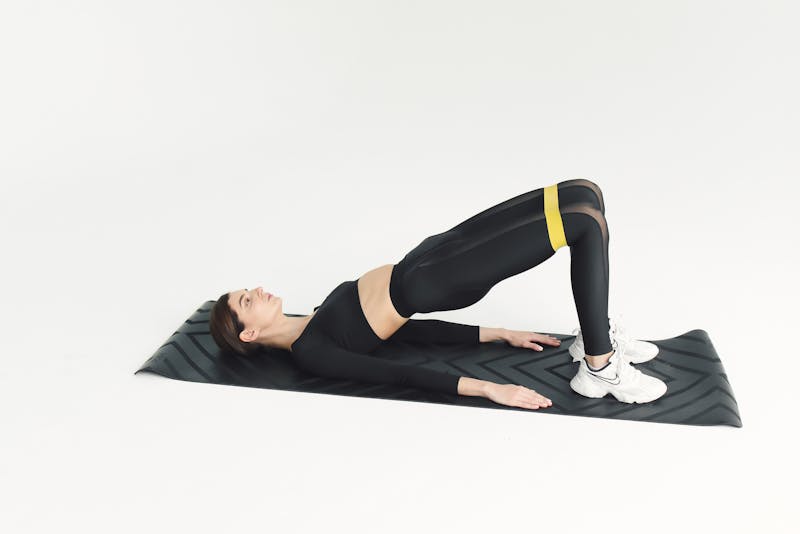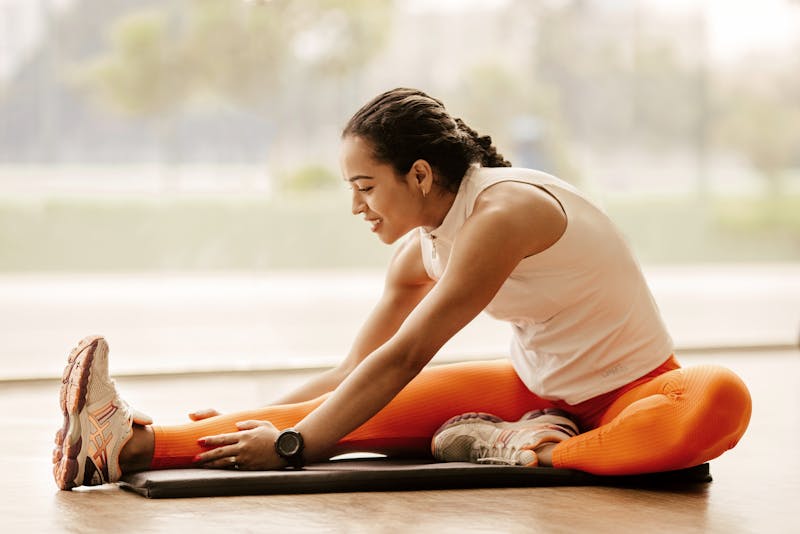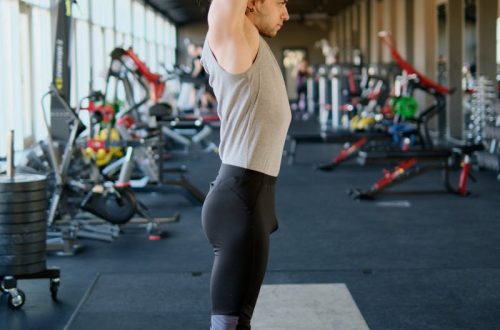- Hamstrings are essential for balance, posture, and movement. Strong hamstrings support walking, running, and bending while preventing stiffness and injury.
- You don’t need gym equipment. Simple bodyweight movements and minimal tools like resistance bands or a sturdy chair are enough to strengthen and stretch hamstrings at home.
- Combine flexibility and strength exercises. A mix of stretches (like standing or wall-assisted hamstring stretches) and strengthening moves (like glute bridges and step-ups) ensures balanced development.
- Form and control matter more than intensity. Avoid rounding your back, swinging your legs, or rushing through reps — focus on slow, controlled movements for safety and effectiveness.
- Train consistently but not excessively. Do 3–5 exercises, 2–3 times a week, allowing time for recovery and gradual progress.
- Warm up before and stretch after workouts. Proper warm-ups prevent strains, while post-exercise stretching helps reduce tightness.
- Progress gradually. Increase resistance, reps, or duration over time as your strength and flexibility improve.
Strong hamstrings are crucial for overall lower-body health, balance, and mobility. Located at the back of the thigh, the hamstrings play a vital role in walking, running, bending, and even sitting. Yet, many people neglect this muscle group in favour of the quads or calves, leading to imbalances that may cause stiffness, pain, or even injury.
For health-conscious people, strengthening the hamstrings doesn’t need to involve fancy gym machines or heavy weights. In fact, with just your bodyweight and minimal equipment, you can build hamstring strength right at home. The best part? These exercises are beginner-friendly, making them accessible whether you’re just starting your fitness journey or looking for simple ways to improve leg strength and flexibility.
In this guide, we’ll explore 10 beginner-friendly hamstring exercises you can do at home, complete with instructions, benefits, and tips to ensure safety and effectiveness.
Why Should You Focus on Your Hamstrings?
Before jumping into the exercises, it’s important to understand why hamstring training is essential. For many people, weak or tight hamstrings are a hidden problem that affects posture, daily movement, and athletic performance. Here’s why you should care:
- Prevents injuries – Strong hamstrings reduce the risk of strains, tears, and knee problems.
- Improves posture – Balanced hamstrings help align the hips and spine, easing lower back tension.
- Supports athletic performance – From running to jumping, hamstrings power explosive movements.
- Aids flexibility – Training the hamstrings enhances mobility and reduces stiffness.
- Balances the legs – Working hamstrings prevents muscle imbalances with the quadriceps.
Whether you’re aiming for fitness, sports, or simply staying pain-free, your hamstrings deserve attention.
1. Standing Hamstring Stretch: A Gentle Start
For beginners, stretching the hamstrings is the best way to activate them before strength work. The standing hamstring stretch loosens tight muscles and prepares your body for movement.
How to do it:
- Stand tall with feet hip-width apart.
- Place your right heel on a low step or sturdy chair.
- Keep your leg straight and toes pointed up.
- Hinge forward at the hips while keeping your back straight.
- Hold the stretch for 20–30 seconds before switching legs.
Benefits:
- Improves flexibility.
- Reduces risk of hamstring strain.
- Eases lower back tension.
Tips:
- Avoid rounding your back.
- Don’t force the stretch—move only until you feel a gentle pull.
2. Glute Bridge: Activating the Hamstrings and Glutes

The glute bridge is one of the most effective starting exercises for activating the muscles at the back of your body. It works the hamstrings, glutes, and lower back while requiring no special equipment. This simple movement also builds strength that carries over into everyday actions such as walking, getting up from a chair, and climbing stairs.
How to perform it:
- Lie flat on your back; bend your knees and feet, resting firmly on the floor.
- Keep your arms relaxed by your sides, palms facing down.
- Press your heels into the floor as you raise your hips off the ground.
- At the top of the movement, tighten your glutes and hamstrings.
- Pause briefly, then lower your hips in a controlled manner back to the starting position.
Benefits:
- Strengthens hamstrings and glutes.
- Improves core stability.
- Relieves lower back stress.
Tips:
- Keep knees aligned with hips.
- Avoid arching the lower back excessively.
3. Seated Hamstring Stretch for Beginners
For those with tight hamstrings, the seated hamstring stretch provides a controlled way to improve mobility. It’s a staple for beginners who may struggle with flexibility.
How to do it:
- Sit on the floor with legs extended straight in front of you.
- Flex your toes upward.
- Slowly hinge forward from the hips, reaching towards your toes.
- Keep your back straight and avoid bouncing.
- Hold for 20–30 seconds.
Benefits:
- Enhances flexibility and mobility.
- Prepares muscles for strengthening exercises.
- Relieves stiffness from prolonged sitting.
Tips:
- If you can’t reach your toes, grab your shins or use a towel around your feet.
- Focus on gradual progress, not forced movements.
4. Hamstring Curls with Resistance Band
Adding resistance bands allows you to train the hamstrings effectively without heavy gym machines. This beginner-friendly variation is safe and simple to perform at home.
How to do it:
- Anchor a resistance band to a sturdy object.
- Lie face down on the floor, securing the band around your ankles.
- Slowly curl your heels towards your glutes.
- Pause, then return to the starting position.
Benefits:
- Builds hamstring strength.
- Improves knee stability.
- Enhances athletic performance.
Tips:
- Start with a light band and progress gradually.
- Control the movement to avoid jerking.
5. Standing Leg Kickbacks
This exercise isolates the hamstrings while also engaging the glutes. It’s great for beginners because it mimics everyday movements like walking and climbing stairs.
How to do it:
- Stand upright with hands resting on a wall or chair for balance.
- Shift weight onto one leg and extend the other leg backwards.
- Keep the extended leg straight but not locked.
- Slowly return to the starting position.
Benefits:
- Strengthens hamstrings and glutes.
- Improves balance and stability.
- Enhances functional strength.
Tips:
- Focus on controlled movements.
- Avoid swinging the leg—engage the muscles instead.
6. Hamstring Exercises at Home: Single-Leg Glute Bridge
This variation of the glute bridge challenges balance while targeting one hamstring at a time. It’s perfect for building unilateral strength.
How to do it:
- Lie on your back with knees bent.
- Extend one leg straight out.
- Press through the heel of the bent leg and lift your hips.
- Hold for 2–3 seconds at the top, then lower slowly.
- Switch legs after 8–12 reps.
Benefits:
- Strengthens each hamstring independently.
- Improves balance and stability.
- Corrects muscle imbalances.
Tips:
- Keep hips level throughout the movement.
- Start with fewer reps if balance is difficult.
7. Step-Ups on a Sturdy Surface
Step-ups mimic climbing stairs and are excellent for beginners aiming to build lower-body strength. With just a chair, box, or step, you can work your hamstrings effectively.
How to do it:
- Stand in front of a sturdy step or box.
- Place your right foot on the step.
- Push through your heel to lift your body up.
- Step down carefully and repeat on the other side.
Benefits:
- Strengthens hamstrings, glutes, and quads.
- Improves coordination and balance.
- Enhances everyday functional movement.
Tips:
- Use a low step to begin with.
- Keep your back straight and avoid leaning forward.
8. Good Morning Exercise (Bodyweight Version)
The good morning exercise strengthens the hamstrings by hinging at the hips. While advanced versions use weights, beginners can start with just bodyweight.
How to do it:
- Stand with feet hip-width apart.
- Place your hands lightly behind your head.
- With a straight back, hinge forward at the hips.
- Lower your torso until you feel a stretch in the hamstrings.
- Return to standing.
Benefits:
- Strengthens hamstrings and lower back.
- Improves posture and core stability.
- Enhances hip mobility.
Tips:
- Avoid rounding your back.
- Keep movements slow and controlled.
9. Wall-Assisted Hamstring Stretch

This is a gentle, beginner-friendly exercise that uses a wall for support. It’s especially effective for people with very tight hamstrings.
How to do it:
- Lie on your back with legs extended up a wall.
- Position your hips close to the wall.
- Relax in this position, letting gravity stretch your hamstrings.
- Hold for 1–2 minutes.
Benefits:
- Provides a passive, relaxing stretch.
- Increases flexibility without strain.
- Reduces post-exercise muscle tightness.
Tips:
- Adjust your distance from the wall to control intensity.
- Focus on breathing deeply during the stretch.
10. Chair-Assisted Deadlift (Beginner Variation)
Deadlifts are excellent for hamstring strength, but beginners may struggle with form. The chair-assisted variation allows you to practise safely at home.
How to do it:
- Stand with a chair in front of you for support.
- Hold the chair lightly with both hands.
- Hinge forward at the hips, keeping your back straight.
- Lower your torso until you feel tension in your hamstrings.
- Return to standing position.
Benefits:
- Strengthens hamstrings, glutes, and core.
- Teaches proper hip-hinge movement.
- Builds a foundation for advanced exercises.
Tips:
- Do not round your spine.
- Keep the movement slow and controlled.
How Often Should You Train Your Hamstrings at Home?
For beginners, consistency is more important than intensity. You don’t need to perform all ten exercises in one session. Instead, select 3–5 movements and perform them 2–3 times per week. Here are a few tips:
- Warm up first – Always start with light stretches to loosen tight muscles.
- Mix stretching and strengthening – Balance flexibility and strength for healthy hamstrings.
- Progress gradually – Increase repetitions or resistance bands over time.
- Listen to your body – Stop if you feel sharp pain.
Common Mistakes Beginners Should Avoid
Even simple hamstring exercises can cause problems if performed incorrectly. Here are common mistakes to watch out for:
- Rounding the back – This puts stress on the spine. Keep your back straight.
- Using momentum – Swinging legs or rushing reduces effectiveness.
- Neglecting balance – Focus on controlled, balanced movements.
- Skipping warm-up – Stretch before exercising to avoid strains.
- Overtraining – Muscles need rest to grow and recover.
Building hamstring strength at home is both achievable and rewarding, especially for beginners. By incorporating these 10 beginner-friendly hamstring exercises, you can improve flexibility, stability, and overall lower-body strength without setting foot in a gym. Whether you’re health-conscious, returning to exercise, or simply aiming to stay active, these movements provide a safe and effective foundation.
The key is consistency. Start small, focus on form, and gradually progress. In time, your hamstrings will not only feel stronger but will also support your daily movements, athletic performance, and long-term joint health.


